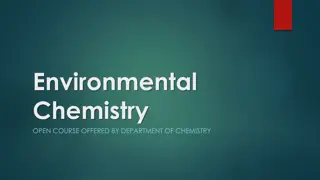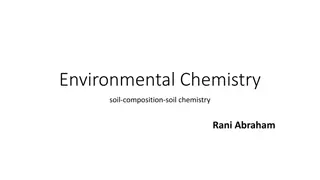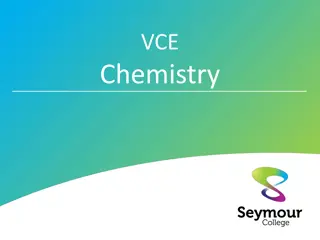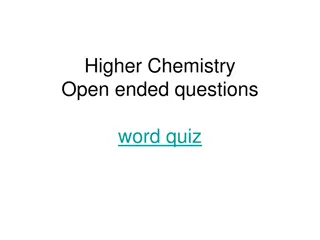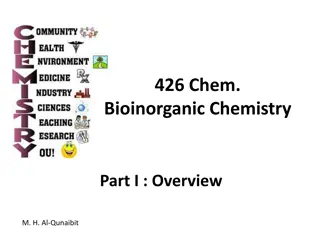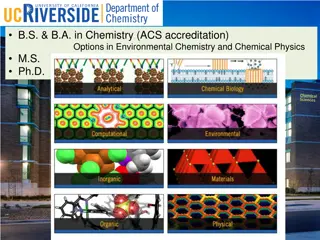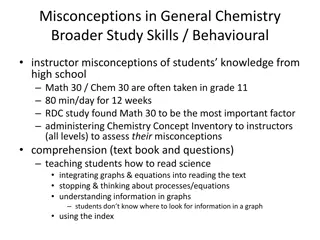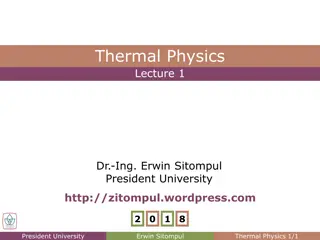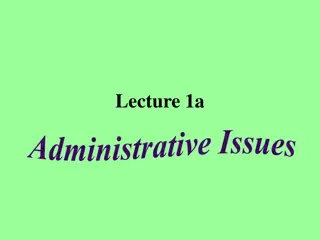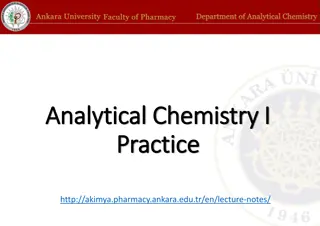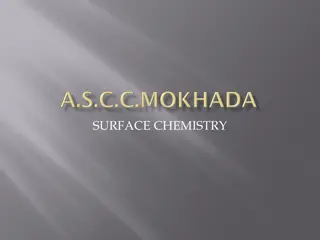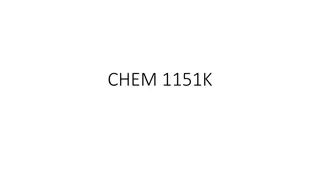Welcome to Chemistry 1B Lecture: Introduction and Course Overview
In this Chemistry 1B lecture, Dr. Roy Dixon introduces the course, instructors, teaching goals, and topics to be covered. Students are briefed on class materials, lab expectations, and the importance of problem-solving skills. The session covers equilibrium, thermodynamics, electrochemistry, and more. Details on roll call, required websites, lab supplies, and class size limits are also provided.
Download Presentation

Please find below an Image/Link to download the presentation.
The content on the website is provided AS IS for your information and personal use only. It may not be sold, licensed, or shared on other websites without obtaining consent from the author.If you encounter any issues during the download, it is possible that the publisher has removed the file from their server.
You are allowed to download the files provided on this website for personal or commercial use, subject to the condition that they are used lawfully. All files are the property of their respective owners.
The content on the website is provided AS IS for your information and personal use only. It may not be sold, licensed, or shared on other websites without obtaining consent from the author.
E N D
Presentation Transcript
Welcome to Chem 1B Lecture Section 1 Today s Meeting Introduction to Class Roll Call (put name on notepad) First Day Stuff: Printed Handout (not the syllabus) Materials Needed Adding this Class Syllabus Lab first two weeks Chem 1A Review (very brief) First Topic: Chemical Equilibria
Introduction Instructors Lecture Roy Dixon PhD in Analytical Chemistry Research in Environmental and Analytical Chemistry Most of my teaching experience is in teaching Analytical Chemistry I taught Chem 1B last fall but otherwise have taught general chemistry infrequently Relatively easy going but not easy grading Laboratory All are experienced Chem 1B instructors Section # Instructor 2, 3, 6, 7* Katie Smith Patrick Sparks Addison Beckemeyer 4 5 Richard Brookins 7* Patrick Sparks * Split lab (Katie Smith first half)
Introduction Class Main Teaching/Learning Goals Lecture Topics: Equilibrium Related Topics (Chapters 14 16) Thermodynamics Electrochemistry Metal-Ligand Chemistry Intro to Organic Chemistry Besides learning topics, there is an emphasis on: Higher level problem solving (can t just use dimensional analysis) Connecting topics to their importance Lab Topics: Qualitative Analysis (what ions are in my water?) Practical aspects of equilibria (titrations) Other topics: thermodynamics, electrochemistry and inorganic chemistry Emphasis on: Report Writing Working Efficiently
Roll Call (today only) Put name on passed sheet
First Day Stuff Class Materials Class Handout summary of materials Websites for Class My faculty website (see handout) Mastering Site (online chemistry homework should be set up) SacCT (not set up yet scores and keys) PAL site (link is up) Text Scantrons (2 types - show) Other Lab Supplies (covered in lab)
First Day Stuff Adding This Class The Class Size is Limited to 144 (24 students per each of 6 lab sections) Adding is done for lab sections Only can add students to make up for dropped students (not showing up will get you dropped) Priority based on waitlist # (for lab section); plus other priorities for crashing students Was briefly full Sections not full (MySacState just before class) Sect # (vacancies): 2 (2), 4 (1), 7 (1) Most students will be added on second meeting with adding possible in 2nd week to replace other dropped students Lecture Only If you are repeating the class and hope to skip the lab, see me
First Day Stuff Syllabus Download from Website It is your responsibility to read and understand the complete syllabus. I will go over certain parts, and you can ask questions Page 1 notes: lab instructor office hours posted on website Sequoia 502 is the Help Office (don t see instructor there about personal problems) A C- in Chem 1A is insufficient Bring a calculator to lecture Safety equipment is necessary to work in lab
First Day Stuff Syllabus cont. Page 2 notes: Lecture will be strongly focused on problem solving and conceptual understanding (meant to compliment book learning) Page 3 notes: Lab attendance is required read if you need to make up a lab Grading breakdowns may be curved downward but most likely by only a few % at most and in conjunction with the other section Quizzes will be held in the lab but will be split between lecture questions and questions related to pre-lab activities
First Day Stuff Syllabus cont. Page 4 notes: Midterm Exams (3 see schedule for dates) Last year, these were 23 multiple choice questions (1 bonus) for 88 points plus one work out problem for 12 points I expect the same format this year The version of the scantron used (SC982-E) allows you to do work out problem on back Examples tests from last year are posted
First Day Stuff Syllabus cont. Page 5 notes: Pay attention to pre-lab assignments and lab report deadlines Don t expect your lab instructor to give you additional time (past the end time of the lab period) Disruptions You are not required to be in lecture, but Others are here to learn and can t pay attention if disruptions are common Help: help office, other office hours, PALs program, private tutors have good study habits early
First Day Stuff Syllabus cont. Page 6 notes: If you drop, you also need to check out of lab Bonus points for student participation (up to 5 points for correct answers) Page 7 notes: Exam dates are not likely to change, but I may get one lectures behind (so could change exam content) Homework should match where we are in lecture See bottom for what you may need to restudy from Chem 1A
First Day Stuff Lab First Two Weeks Day 1: yesterday and today mainly dealing with adding and overview of lab diagnostic quiz is for you to know which parts of Chem 1A we expect you to know read lab manual and understand procedures (many differences from Chem 1A) Day 2: Wed. and Thur. check in (+ adding students) review of Chem 1A material (dissolution in water and solubility)
First Day Stuff Lab First Two Weeks Day 3: Next Wed. and Thur. (no lab Mon./Tu.) Pretty extensive pre-lab and then Exp. 1 (over two lab periods) Only 2nd period quiz
Chem 1A Review Important Aspects for Chem 1B See Bottom of p. 7 of Syllabus Chapter 3 - Nomenclature: = the language of chemistry - First, identify substance (molecule, ion, ionic compound, acid) - ions have charge - molecules vs. ionic compounds: ionic compounds have cation and anion and almost all cations are metals (NH4+ is exception)/molecules are all non-metals - molecule name: prefix first element prefix second element suffix - ionic compound name: metal [oxidation state] anion - anion names: memorize, but only as much as needed
Chem 1A Review Important Aspects for Chem 1B Chapter 3 Nomenclature How to learn: - memorize (use what ever technique works for you e.g. flash cards) + can categorize examples ZnCl2 name = _____; type = ________ OF2 = ____________; type = ________ CuCl = ___________; type = ________ Na2SO3 = _________; type = ________ aluminum chlorite = __; type = ______ nitrous acid = ______; type = ________ = shu = water
Chem 1A Review Important Aspects for Chem 1B Chapter 4 - Aqueous Reactions: - Needed for First Lab - Needed for Chapters 15 and 16 (aqueous equilibria) - Concepts to Know: - Solution concentration (mainly molarity how to calculate) - Dilutions - How substances dissolve into water (differences between molecules and ionic compounds + acids and bases) - Various reactions (e.g. precipitation, gas evolution, etc.) + net ionic equations - Solubility rules
Chem 1A Review Important Aspects for Chem 1B Other skill: Problem solving First determine what the question is asking for Determine data useful in getting the answer Map out how to get to the answer Chapter 4 an example problem (more in lab) A solution is made from 0.202 g of CaCl2 (FW = 110.98 g/mol) using a 250 mL volumetric flask and deionized water (totally dissolves CaCl2). What is the concentration in M? How does the dissolved compound exist? What is [Cl-]? Will any further reactions in water occur? If we add AgNO3 to the above solution, what will occur?
Chem 1B First Topic Equilibrium In Chapter 13 (near end of Chem 1A), we covered kinetics (how fast reactions occur) Past assumption was that meant reaction went to completion (all products plus limiting reagent) Also, unfavorable reactions, such as precipitation of CaCl2 from Ca2+ + Cl- are not supposed to occur at all In some important cases, expected reactions will not proceed totally to completion and unexpected reactions can occur to some extent
Chem 1B - Equilibrium Introduction Reactions that can occur in both the forward and reverse reactions to an appreciable extent are represented with a two way arrow: A + B C or A + B What does this mean? From a molecular scale, reactions are occurring in both the forwards and backwards direction When the forward rate (loss of A to form C) is equal to the backwards rate (gain of A from C), the system is said to be in equilibrium and concentrations don t change C (easier to type this)
Chem 1B - Equilibrium Introduction Graphic example of reaction: A + B C (assume [A] = [B] at start) In the beginning, forward rate is fast (as A and B are high). At the points the lines cross, [A] = [B] = [C], but the forward rate is still faster than the backwards rate. We can see that [C] is favored over [A] and [B] because its final conc. is higher. Conc. (C) Conc. (A and B) Time
Chem 1B - Equilibrium Introduction Some examples: 1. Carbon dioxide (CO2) is not very soluble (you are supposed to know it forms from acid + carbonates) However, the acidity of rain in pristine conditions is supposed to be based on dissolution of CO2: CO2 (g) + H2O (l) H2CO3 (aq) 2. Nitrogen gas (N2) is difficult to react because of the strength of its triple bonds, however under certain conditions, beneficial and problematic reactions involve N2 where both reactants and products exist. a) N2 (g) + 3H2 (g) 2NH3 (g) (used in fertilizer) b) N2 (g) + O2 (g) 2NO (g) (source of smog from combustion) Conditions are critical to make a) go but to limit b) H+ + HCO3-
Chem 1B - Equilibrium Equilibrium Constant and Equation Whether an Equation favors reactants or products is determined by an EQUILIBRIUM CONSTANT (K) as well as reaction stoichiometry Generic reaction: aA + bB K = equilibrium constant and for above reaction, b B A cC + dD c d C D K = a A larger K value means products are more favored
Chem 1B - Equilibrium Equilibrium Equation Further Details Technically, instead of concentration we have a concentration ratio to a standard state (e.g. 1 mol/L) we can ignore this, but this is why K is unitless Only species in gas phase or in solution will have concentrations. Solids and pure liquids are not included. When gases are involved, there are two Ks: KC for concentration units (including gases) and KP in which pressure (atm) replaces concentration (assume K = KC unless specified) Even further corrections (activity and fugacity) are needed under certain conditions but are beyond this class
Chem 1B - Equilibrium Equilibrium Equation Example N2 (g) + O2 (g) 2NO (g) N 2 2 P NO KC= or K = NO P O P P N O 2 2 2 2 At T = 25 C KC = KP (in this case) = 4 x 10-31 an insignificant amount of NO will form in air: PN2 = 0.8 atm , PO2 = 0.2 atm; rearranging the above equation, PNO = [KPPN2PO2]0.5 = 2 x 10-16 atm Equilibrium at room temp. is not realistic because kinetics is too slow (insufficient collision energy to break triple bond) At car engine temp., reactions are faster and K is much larger. This leads to significant NO formation. Fuel rich conditions (low PO2 ) can limit NO formation.





